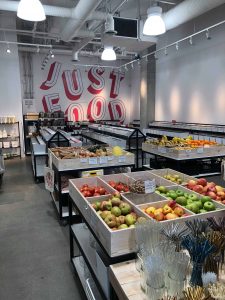I love when courses begin to intersect and compliment one another! A few weeks ago, my group and I were required to complete a comm 395 assignment (Business Communications) – this assignment required us to find a local business , research on them and meet with a representative to discuss the companies sustainability initiatives (environmental, economic or otherwise ).
Luckily, a friend refered Nada to me. So whats so special about Nada? What differentiates if from other grocery stores? Well, Nada operates on a “Just Food” system .

This “Just food ” system is intergrated throughout their supply chain and daily business in the following ways :
1.The store does not stock plastic packaged items : If any items are packaged, the packaging is usually compostable, or recycled material. However, most of their products have no packaging at all. For example, their grains, seasonings, and other edible items are all stored and displayed in big open bins . It is up to customers to choose the amount they need . I.e. Just want 330grams of Turmeric? or only 3 eggs? You can absolutely do that! No fixed packaging which often leads to packaging waste and excess of food.
2.Bring your own containers – Apart from choosing your own quantity of items, customers must either bring their own reusable containers (I.e. a jar to fill rice in ) or buy a reusable container from the store. As well as bring your own tote or grocery bag – no plastic bags at Nada!
3. Nada requires suppliers to follow these rules too, as best as they can! Which means, they prefer and communicate to suppliers not to use plastic when delivering goods etc. In fact, they try to source locally as much as they can to : a.Support the local economy b.Reduce pollution from road travel (for deliveries). Due to this, Nada also only provides produce that is in season!
4.Bonus! Nada has an in house cafe! To make things better, the cafe uses mostly produce that is left behind in the store. For smoothies, cakes etc. This ensures foodwaste is kept to a minimum and the loop is closed 🙂
Of course, there is soo much more to this store. Such as no paper receipts (email only) and tonnes of social initiatives as well.
Do yourself a favour and check them out!

Hi Ritual,
WOW, such a well written overview of Nada. I have never heard of them, and I am so happy I found this article because this is exactly what I have been looking for. In order to relate to this post back to the course, have you thought of ways in which this business model can be upscaled and expanded to more locations? Specifically, do you think that the large mainstream grocery stores could slowly adopt a similar model? Further, do you think ‘less woke’ consumers will shift their behavior?
Thanks!
Nada is so cool! I did a group project on it for my Consumer Behavior class last semester. I love how Nada came to be, the founder was a marine biologist and when she noticed the abundance of plastic, trash, and waste cluttering the oceans, she wanted to make a difference. Thus, Nada came to be! When it comes to waste, grocery stores do produce a lot of it so it’s definitely time to reinvent and reimagine what grocery stores look like. For decades, grocery stores have been the same with little to no innovation. And now, I think we’re heading in the right direction. I think it’ll take a while for the everyday consumer to get on board with grocery shopping at Nada. Convenience is still a key factor in people’s purchasing decisions – however, I do think that zero-waste grocery stores are the future!
Hi Ritual! Nada is such a great store- I’ve never been but I’ve heard a lot about it. I am impressed with the many strategies and elements they have incorporated in order to reduce their impact on the environment. I just did a quick scan of their website- it looks like they’ve donated $3,500 to different charitable organizations and have diverted 30,565 containers from landfills- amazing! https://www.nadagrocery.com/
I think something that initially is difficult about converting to zero waste (or at least creating a lot less waste) is the initial cost required- investing in reusable mugs, bottles, jars, utensils, bamboo toothbrushes, grocery bags, produce bags, straws, etc.- the list goes on. I’m curious about pricing at Nada- it seems more catered to upper or upper-middle classes. I wonder if there is an opportunity to make Nada more accessible with lower price points (or if a low-cost Nada could pop up in Vancouver soon?) Anyways- thanks for your post! 🙂
Hi Madison! Thank you for your comment! And yes, your stats are absolutely right- Nada, for its small size, already seems to be making a huge contribution 🙂
Pricing was something we actually did not have the opportunity to discuss with Nada. But my best guess would be scalability – currently, the business is just shy of its first birthday and operating on low inventory, lower customer walk in rate than they would hope. While I don’t think that prices would be as competitive as a “No-frills”, I definitely think that as Nada grows, it will develop the power to reduce its prices and still make a profit.
Your blog post was like a guiding light on this subject. The information was presented in a way that made it accessible to readers of all levels of expertise. To gain a deeper understanding, click here.